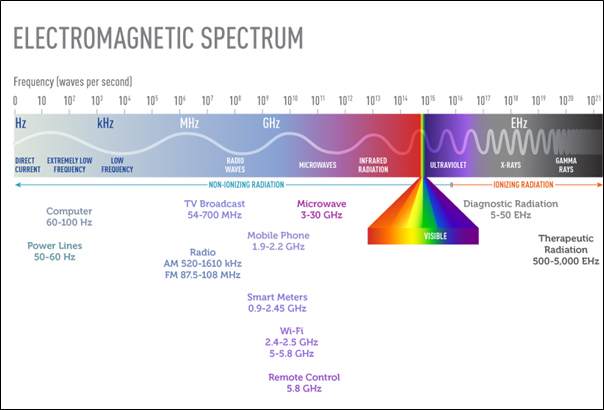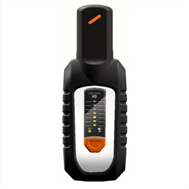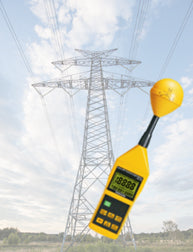What are Electric and Magnetic Fields
Electric fields exist whenever a positive or negative electrical charge is present and exerts forces on other charges within a field. The standard unit for measuring electric field strength is volt per metre (V/m).
Here are some more facts about electric fields:
- Any charged electrical wire produces an associated electric field.
- A field will exist even when there is no current flowing.
- The higher the voltage, the stronger the electric field.
- Electric fields are strongest when close to a charge or charged conductor, and their strength rapidly diminishes in proportion to the distance from the source. Other things that can impede the strength of the field include metal shields, walls, buildings, and trees. For example, electric fields around powerlines are reduced within a home by walls and trees. Powerlines buried underground will exert a barely detectable electric field.
Magnetic fields arise from the motion of electric charges. The most common unit for measuring magnetic field strength is in amperes per meter (A/m); or, more commonly in electromagnetic field research, scientists specify a related quantity, the flux density (in microtesla, µT) instead.
Some other facts about magnetic fields include:
- Unlike electric fields, a magnetic field exists when a device is on and produces a current flow. The higher the current, the greater the strength of the magnetic field.
- The strength of magnetic fields does not diminish due to conventional materials such as the walls of buildings.
- As with electric fields, magnetic fields are strongest when close to their origin and quickly decrease at distances further from the source.

Figure 1 Summary of the similarities and differences between Electric and Magnetic Fields
Wavelength Overview
One of the main characteristics defining an electromagnetic field (EMF) is its frequency or corresponding wavelength. Fields of different frequencies interact with the human body in different ways.

Figure 2 The electromagnetic spectrum represents all of the possible frequencies of electromagnetic energy. It ranges from extremely long wavelengths (extremely low-frequency
exposures such as those from power lines) to extremely short wavelengths (x-rays and gamma rays) and includes both non-ionizing and ionising radiation. Ref. National Cancer Institute
In Figure 2, you can see the electromagnetic waves as being a series of very regular waves that travel at the speed of light. The frequency is the number of either oscillations or cycles per second where the wavelength is the distance between waves. Wavelength and frequency are intertwined; the lower the frequency greater the wavelength, and the higher the frequency, the shorter the wavelength.

Figure 3 Electromagnetic fields form when a magnetic field (blue) coupled with an electric field (red). Magnetic
and electrical fields of an electromagnetic wave are perpendicular to each other and the direction of the wave.
What is the difference between non-ionising electromagnetic fields and ionising radiation?
Electromagnetic waves get carried by particles called quanta. Quanta of higher frequency (shorter wavelength waves) carry more energy than lower frequency/longer wavelength fields.
Ionising radiation:Some electromagnetic waves carry so much energy per quantum that they can break bonds between molecules. Higher-frequency EMFs, which include gamma rays and x-rays, are in the ionising radiation portion of the electromagnetic spectrum. Such waves can cause direct damage to DNA or living cells.
Non-ionising radiation: Non-ionizing radiation includes EMF frequencies at the relatively long wavelength and low-frequency end of the electromagnetic spectrum. Unlike ionising radiation, their quanta are unable to break chemical bonds. Examples of non-ionising radiation include; magnetic fields from electric power lines, home appliances, static fields, radio waves, microwaves, infrared radiation, and visible light. Low- to mid-frequency EMFs include extremely low-frequency EMFs (ELF-EMFs) and radiofrequency EMFs.
Sources of Non-Ionising EMF
There exist both natural and human-made sources of non-ionizing EMFs.
Natural: The Earth's magnetic field, which causes the needle on a compass to point North, is an excellent example of a naturally occurring EMF.
Human-made: Human-made EMFs fall into the ELF and radiofrequency categories of the non-ionising areas of the electromagnetic spectrum. There are several sources of EMFs (see figure 4 below.)

Figure 4 The electromagnetic spectrum complete with sources of both ionizing and non-ionizing radiation.
EMF Meter Examples
Below, the Instrument Choice Scientists feature three new personal EMF measuring devices designed for workers near antennas and multi-use tri-axis meters.
NEW SATIMO EME Guard XS 40GHZ EMF Monitor
Product Code: IC-EME GUARD XS 40
The IC-MVG EME Guard XS is an EMF measuring device designed to  alert workers of potentially harmful levels of EMF when working near antennas. The meter continually scans for electromagnetic waves, and via its built-in alarm and visual system, alerts users when EMFs exceed recommended limits. This Radio Frequency (RF) safety tool is straightforward to use and creates a safer working environment for workers tasked with installation and maintenance.
alert workers of potentially harmful levels of EMF when working near antennas. The meter continually scans for electromagnetic waves, and via its built-in alarm and visual system, alerts users when EMFs exceed recommended limits. This Radio Frequency (RF) safety tool is straightforward to use and creates a safer working environment for workers tasked with installation and maintenance.
Specifications
Frequency Range: 80 MHz - 40 GHz
Probe: Isotropic 3-axes probe

NEW Satimo EME Guard - Personal Safety Monitor for Electromagnetic Levels
Product Code: IC-EME GUARD
The IC-EME Guard is a broadband personal exposure meter. The unit continuously records the electromagnetic field level and alerts the user to potential over-exposure. This unit features a recording capacity of 30,000 measurements and a user-selectable recording period between 1 and 255 seconds.
Specifications
Frequency Range: 27 MHz to 40 GHz
Probe: Isotropic 3-axes probe
TM-196 3-Axis RF Field Strength Meter
Product Code: IC-TM-196
 The IC-TM-196 is ideal for measuring and monitoring Radio Frequency (RF) electromagnetic field strength. The unit features a configurable alarm threshold, memory function, overload indication. This EMF meter produces results in the following measurement units: mV/m, V/m, uA/m, mA/m, uW/m2, mW/m2, uW/cm2.
The IC-TM-196 is ideal for measuring and monitoring Radio Frequency (RF) electromagnetic field strength. The unit features a configurable alarm threshold, memory function, overload indication. This EMF meter produces results in the following measurement units: mV/m, V/m, uA/m, mA/m, uW/m2, mW/m2, uW/cm2.
Specifications
Frequency Range:10 MHz to 8 GHz
Probe: Isotropic 3-axes probe
Conclusion
Want to know more about essential EMF meter definitions, then read the Instrument Choice article 'EMF Meters; How to read specifications.' You can browse the full range of EMF meters here.
If you need assistance finding the best EMF meter to suit your measurement needs or to find a meter with the correct frequency range, contact one of the Instrument Choice Scientists. We're here to help! Call 1300 737 871 or email customer-service@instrumentchoice.com.au.
